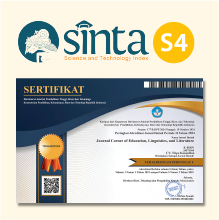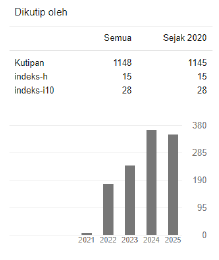The Implementation of Repetition and Chain Drill at Akademi Maritim Nusantara Cilacap
 https://doi.org/10.54012/jcell.v2i1.54
https://doi.org/10.54012/jcell.v2i1.54
 Abstract views: 812
Abstract views: 812
 PDF downloads: 358
PDF downloads: 358
Keywords:
Audio-Lingual Method, Classroom Action Research, Chain Drill, RepetitionAbstract
The act of communicating using English is still an obstacle for students, especially for countries that make English as a foreign language. English conversation must be mastered fluently by students of Akademi Maritim Nusantara Cilacap, especially the Nautical Sciences Study Program. This becomes an obligation because as seafarers, graduates will definitely have to deal with many people from other countries. Learning English conversation by imitation is seen as still relevant when viewed from the position of English as a foreign language in Indonesia. This study aims to see the impact of applying repetition and chain drill methods in learning Maritime English at the Akademi Maritim Nusantara Cilacap. The Repetition and Chain Drill methods are part of a language teaching method called the Audio-Lingual Method. Both methods are implemented in one Nautical Science class which contains 33 students. With the help of 33 Nautical program students, the research was done utilizing the Classroom Action Research approach. Three study steps yielded the necessary data. Researchers assess each student’s fluency and pronunciation in various ways. The results showed that there was an increase in the average value between stages. It also proves that learning with repetition and chain drill methods helps students start English conversation.
Downloads
References
Abu-Melhim, A. (2009). Re-evaluating the effectiveness of the audio-lingual method in teaching English to speakers of other languages. In International Forum of Teaching and Studies (Vol. 5, No. 2, pp. 39-45). American Scholars Press, Inc.
Aini, N., Khoyimah, N., & Santoso, I. Improving Students Speaking Ability Through Repetition Drill.
Anum, A., & Apriyanto, S. (2019). Detecting Gender’S Strategies in Learning Speaking. Premise: Journal of English Education, 8(1), 57. https://doi.org/10.24127/pj.v8i1.1932
Apriyanto, S. (2019). Gender Strategies in Learning English (Junaidi (ed.); 1st ed., Vol. 73). Sulur Pustaka. www.sulur.co.id
Apriyanto, S., & Anum, A. (2018). Gender Dynamics on Speaking Interaction in the College Classroom. Jurnal Smart, 4(2), 73. https://doi.org/10.26638/js.692.203x
Apriyanto, S., & Nurhayaty, A. (2019). Born In Social Media Culture: Personality Features Impact In Communication Context. In Y. Nasucha (Ed.), icollit (pp. 167–175). UMS Press. icollit.ums.ac.id/2018
Bagheri, M., Hadian, B., & Vaez-Dalili, M. (2019). Effects of the Vaughan Method in Comparison with the Audiolingual Method and the Communicative Language Teaching on Iranian Advanced EFL Learners’ Speaking Skill. International Journal of Instruction, 12(2), 81-98.
Brown, D. (2003). Language Assessment: Principles and Classroom Practices. New York: Pearson ESL.
Brown, D. (2006). Principles of Language Learning and Teaching. New York: Pearson Longman.
Brown, D. (2007). Teaching by Principles: An Interactive Approach to Language Pedagogy. New York: Pearson PTR Interactive.
Brown, H. D., Kosslyn, S. M., Breiter, H. C., Baer, L., & Jenike, M. A. (1994). Can Patients With Obsessive-Compulsive Disorder Discriminate Between Percepts And Mental Images? A Signal Detection Analysis. Journal Of Abnormal Psychology, 103(3), 445.
Dalman, Hesti, & Apriyanto, S. (2020). Conversational implicature: A pragmatic study of “our conversation” in learning at university. International Journal of Psychosocial Rehabilitation, 24(8), 4332–4340.
Geetha, S., & Ahammed, C. K. (2020). Approaches and Theories in ELT.
Herlisya, D., & Wiratno, P. (2022). Having Good Speaking English through Tik Tok Application. Journal Corner of Education, Linguistics, and Literature, 1(3), 191–198. https://doi.org/10.54012/jcell.v1i3.35
Hidayat, O., & Apriyanto, S. (2019). Drama Excerpt : Tool in Enhancing Speaking Ability for Junior High School. IJECA (International Journal of Education and Curriculum Application), 2(3), 1–9.
Hinkel, E. (2006). Current perspectives on teaching the four skills. Tesol Quarterly, 40(1), 109-131.
Kakunta, K., & Kamanga, W. (2020). Microteaching: Audio-lingual Method. Journal Educational Verkenning, 1(1), 25-30.
Kartikasari, E., Arifin, Z., & Salam, U. (2015). Improving Students’ Speaking Ability Through Repetition Drill (Doctoral dissertation, Tanjungpura University).
Kasiyarno, Santoso, D., & Apriyanto, S. (2020). Intercultural Communication and Business Chain Formation of America and Japan. 12(2), 2042–2052.
Khoyimah, N., & Santoso, I. (2020). Improving Students Speaking Ability through Repetition Drill. PROJECT (Professional Journal of English Education), 3(1), 26-35.
Kunandar, S. P. (2008). Langkah Mudah Penelitian Tindakan Kelas sebagai Pengembangan Profesi Guru. Jakarta: PT Raja Grafindo Persada.
Larosa, N. (2020). The Implementation of Repetition Drill in Teaching Speaking Skill (Doctoral dissertation, STKIP Bina Bangsa Getsempena).
Larosa, N., Qamariah, H., & Rosdiana, R. (2020). The Implementation of Repetition Drill in Teaching Speaking Skill. Jurnal Ilmiah Mahasiswa Pendidikan, 1(1).
Larsen-Freeman, D. (2000). Techniques and principles in language teaching. Oxford University.
Mardhiyah, A. H. (2020). Using Repetition Drill in Teaching Speaking for 4th Grade Students in Ta’miriyah Elementary School Surabaya (Doctoral dissertation, Universitas Airlangga).
Mart, C. T. (2013). The audio-lingual method: An easy way of achieving speech. International Journal of Academic Research in Business and Social Sciences, 3(12), 63.
Nissa, R. N., Nurchurifiani, E., & Febriyanti. (2021). Improving S tudents ’ Vocabulary Mastery Through the Keyword Technique At The Tenth Grade of SMAN 2 Tulang Bawang Tengah. Journal Corner of Education, Linguistics, and Literature (JCELL), 1(2), 139–147. https://doi.org/10.54012/jcell.v1i2.28
Nurchurifiani, E., Nissa, R. N., & Febriyanti, F. (2021). Improving Students’ Vocabulary Mastery Through the Keyword Technique At The Tenth Grade of SMAN 2 Tulang Bawang Tengah. Journal Corner of Education, Linguistics, and Literature, 1(2), 139–147. https://doi.org/10.54012/jcell.v1i2.28
Sagita, I. K. (2021a). Applying Conversation Method and Self-Confidence and Its Effect to Learning Achievement. Journal Corner of Education, Linguistics, and Literature, 1(2), 122–131. https://doi.org/10.54012/jcell.v1i2.11
Sagita, I. K. (2021b). Applying Conversation Method and Self-Confidence and Its Effect to Learning Achievement. Journal Corner of Education, Linguistics, and Literature (JCELL), 1(2), 122–131. https://doi.org/10.54012/jcell.v1i2.11
Salma, N., & Prastikawati, E. F. (2021). Performance-Based Assessment in the English Learning Process: Washback and Barriers. Getsempena English Education Journal, 8(1), 164-176.
Santoso, D., & Apriyanto, S. (2020). Pragmatics implicature analysis of police interrogation: Forensic linguistics analysis. International Journal of Psychosocial Rehabilitation, 24(6), 115–124. https://doi.org/10.37200/IJPR/V24I6/PR260009
Tice, J. (2004). Making Drilling Meaning. Available in: http://www.englishonline.org.cn/en/teachers/workshops/drilling/teachingtips/drill-articles//tabs-212580-1. Retrieved on: June 20, 2016
Vidhiasi, D. M., & Lengari, Y. G. P. (2018). The Implementation of Audio Lingual Method in Teaching Grammar. Saintara: Jurnal Ilmiah Ilmu-Ilmu Maritim, 2(2), 13-18.
Downloads
Published
How to Cite
Issue
Section
License
Copyright (c) 2022 Dhion Meitreya Vidhiasi

This work is licensed under a Creative Commons Attribution-ShareAlike 4.0 International License.
All articles published in the Journal Corner of Education, Linguistics, and Literature are licensed under the Creative Commons Attribution-ShareAlike License (CC BY-SA).

















